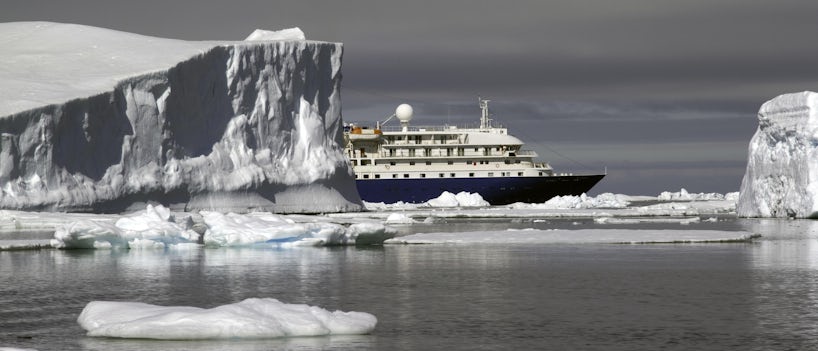
The World's Roughest Waters for Cruising


On This Page
- Ocean Crossings Are Rougher Than More Protected Waters
- The Mediterranean Sea Can Be Surprisingly Choppy Year Round
- Expect Rougher Caribbean Seas in the North and East
- Alaska Cruises Can Be Bumpy in the Gulf of Alaska
- Bermuda and the Bahamas Are a Bit Less Sheltered Than the Caribbean
- The Drake Passage on the Way to Antarctica Is Notoriously Intense
- You'll Find Some Rough Waters in the South China Sea and Elsewhere
- Australia
- Africa
Oh, those fickle seas! Although it's atypical to sail on a cruise ship through the roughest waters and worst weather, you might be surprised to learn that ships regularly traverse some roiling seas.
Many cruise lines -- including Carnival, Royal Caribbean and Norwegian -- have multiple ships sailing to the Caribbean out of Florida and the Gulf States throughout hurricane season (though the vessels will make itinerary changes to shy away from the biggest storms). Almost all Antarctica cruises have to traverse the infamously choppy Drake Passage, and Alaska cruises must emerge from the sheltered Inside Passage into the rougher waters of the Gulf of Alaska or the Pacific to reach their homeports. Cunard also does its transatlantic cruises throughout the winter, sometimes attracting passengers who specifically want to sail on rougher seas.
If you're prone to seasickness or just want to be prepared for high seas and rolling waves, we've compiled a list of some of the bodies of water known for their chop.
Ocean Crossings Are Rougher Than More Protected Waters
Rough Waters: Oceans are nearly always choppier than seas because they're less protected from sheltering land masses. If you've booked a transatlantic cruise (especially in the cooler months) or a transpacific cruise (including cruises sailing to Hawaii), you may encounter some bumps. The North Atlantic by northern Canada has its fair share of high seas, as well.
Impacted Itineraries: Transatlantic, transpacific, Hawaii, Canada and New England, world cruises
The Mediterranean Sea Can Be Surprisingly Choppy Year Round
Rough Waters: Cruise travelers might experience rough seas in several places in Europe. The biggest offender is the Mediterranean, which tends to be roughest in the fall and winter, due to winds and storms. However, avid cruisers have experienced rough seas in the spring and summer, so be prepared for anything. The Bay of Biscay, off the west coast of France and north of Spain, and the North Sea can also be rough, but are calmer in the summertime.
Impacted Itineraries: Eastern and Western Mediterranean, Western Europe, Baltic and Northern Europe
Expect Rougher Caribbean Seas in the North and East
Rough Waters: When one body of water runs into another, waves tend to be higher and rougher. Although the Caribbean is generally known for smooth sailing, it can get choppy in areas where it meets up with the Atlantic Ocean. In addition, tropical depressions, storms and hurricanes that crop up during hurricane season (June 1 to November 30) can also stir up the usually calm Caribbean waters and make for a rocky trip -- even if your ship is changing course to avoid the brunt of the storm.
Impacted Itineraries: Eastern, Southern and Western Caribbean
Alaska Cruises Can Be Bumpy in the Gulf of Alaska
Rough Waters: The majority of sailing on an Alaska cruise is done in the protected waters of the Inside Passage, but ships sailing to Seward, Whittier or Anchorage must cross the Gulf of Alaska, which is much rougher. Cruise staffers say the gulf gets especially bad after Labor Day, in the shoulder season.
Impacted Itineraries: One-way Alaska sailings
Bermuda and the Bahamas Are a Bit Less Sheltered Than the Caribbean
Rough Waters: While cruises to Bermuda and the Bahamas from the East Coast are usually smooth, squalls can arise on the Atlantic Ocean, particularly during hurricane season. The bigger your ship, the less you'll feel the waves. Because cruises that sail to Canada hug the New England shoreline, the ocean isn't as tempestuous unless there's a Nor'easter in the forecast.
Impacted Itineraries: Bermuda, Bahamas, Eastern Caribbean, Canada/New England.
The Drake Passage on the Way to Antarctica Is Notoriously Intense
Rough Waters: One of the most notorious places for rock-and-roll cruising is the Drake Passage, the body of water between Cape Horn -- the southernmost tip of South America -- and the South Shetland Islands in Antarctica. Although you can get lucky and find smooth seas, most cruise travelers experience rough waters traversing this region. Take your favorite seasickness remedies and look at it as part of the experience.
Impacted Itineraries: Antarctica
You'll Find Some Rough Waters in the South China Sea and Elsewhere
Rough Waters: The typhoon season in the northwest Pacific Ocean is mainly from July to November with a peak in late August/early September -- although storms can occur year-round. Encounter a storm in the South China Sea or other Asian waters, and you could find an unpleasant ride, not to mention some skipped ports.
Impacted Itineraries: China, Japan, the Philippines and Korea
Australia
Rough Waters: If you're cruising Down Under, you'll find some rough patches in the Bass Strait (between the Australian mainland and Tasmania) and the Tasman Sea (between Australia and New Zealand).
Impacted Itineraries: Australia and New Zealand cruises, world cruises
Africa
Rough Waters: Not many cruise lines sail to Africa, but if your itinerary includes South African destinations, watch out! The waters around the Cape of Good Hope, especially where the Atlantic meets the Indian Ocean, can be pretty choppy.
Impacted Itineraries: world cruises, Africa cruises